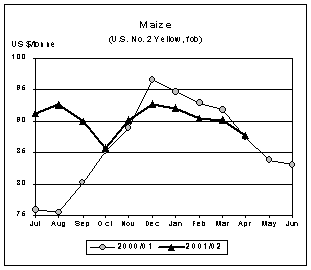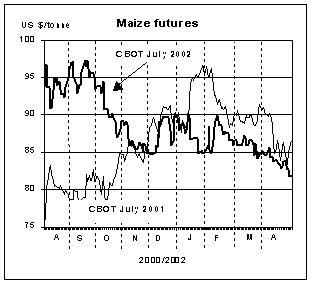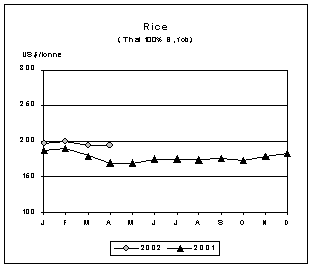| 2002 | 2001 | ||
| April | Jan. | April | |
| (. . . . . . US$/tonne . . . . . .) | |||
| United States | |||
| Wheat 1/ | 125 | 128 | 130 |
| Maize | 88 | 92 | 87 |
| Sorghum | 90 | 97 | 96 |
| Argentina 2/ | |||
| Wheat | 119 | 115 | 120 |
| Maize | 86 | 89 | 80 |
| Thailand 2/ | |||
| Rice white 3/ | 195 | 197 | 170 |
| Rice, broken 4/ | 149 | 145 | 122 |
Since the start of the current marketing season in July, monthly international wheat prices have manifested very little variation and remained within a narrow range, although at generally lower levels than in the previous season. While during the earlier months of this season, some upward movements in prices could not have been ruled out, especially in view of the smaller world production in 2001 and larger global import demand, the potential for a sustained rally was largely compromised by the arrival on the market of unexpected surpluses from a number of non-traditional exporters. In April, U.S. wheat No. 2 (HRW, fob) averaged around US$125 per tonne, down US$3 per tonne from January and US$5 per tonne less than in the corresponding month last year. Argentine prices for the new crop have faired slightly better in recent months. The ongoing economic difficulties, uncertainties regarding the peso/dollar exchange rates and the recently introduced export taxes do not provide the ideal conditions for a sustained recovery in Argentine export prices.

Wheat futures have trended downward in recent months. By late April, the July futures for soft red winter wheat at the Chicago Board of Trade (CBOT) were quoted at US$100 per tonne, down US$9 per tonne from January and US$1 per tonne lower than in the previous year. Given good crop prospects for 2002, the expected decline in world import demand and large export availabilities across several non-traditional exporters, the decline in international wheat prices is likely to persist in the coming season.

Maize export prices have also suffered from large world export supplies and weak global import demand. Since January, international prices have remained under downward pressure, with China and Brazil making large exports. At this time of the year, the market is largely influenced by the weather situation, as well as the size of the new crop in the northern hemisphere. Thus, a generally favourable production outlook has resulted in a sharp decline in prices over the past few months. In April, U.S. No. 2 maize (fob) averaged US$87 per tonne, down US$5 per tonne since January and equal to the price a year ago. Reflecting expectations regarding production in 2002 and demand developments, the

CBOT maize futures for July have remained mostly below last year's levels. However, demand for world maize utilization in 2002/03 is seen to exceed the expected production; hence, the balance would have to be drawn down from stocks. More impartially, price developments would depend on the size of overall exportable supplies among the major exporters as well as among non-traditional exporters.

Notwithstanding the arrival of new rice crop supplies in some major exporting countries, international prices for rice held relatively steady in the first quarter of 2002 and the FAO Export Price Index for Rice (1982-84 =100) averaged 90 points in April, unchanged from March, and only 1 point less than in January and February. In comparison, the Index stood at 87 points in April 2001. Much of the price resilience reflected the programme of intervention purchases in Thailand, where the Government appears determined not to let prices fall the way they did a year ago. As a result, the quotations of Thai origin rice remained relatively firm in the past two months and substantially higher than the levels prevailing in the same period in 2001. For instance, in April 2002, Thai 100%B averaged US$195 per tonne compared with US$170 per tonne in April 2001. This tendency contrasted with the steady decline in rice quotations in the United States, where the f.o.b. price average for 2/4 long rice fell for the 10th consecutive month to US$199 per tonne in April 2002. As a result, the price differential between Thai and US high quality long grain rice shrank to US$2 per tonne in April 2002, compared with US$101 per tonne a year earlier.
As for most types and qualities exported from Thailand, sale prices were steady or stronger in Pakistan, both for Basmati and IRRI rice. Quotations in Viet Nam, which had weakened in March when supplies from the winter/spring crop reached the market, showed a general tendency to recover in April. By contrast, most Indian rice prices weakened compared with the levels prevailing earlier this year. As a result, rice of Indian origin remained the most competitive on the market.

Although prospects for international rice prices in the coming months have brightened following the announcement of a surge in imports by Indonesia, there is still considerable uncertainty regarding purchases by China. The price outlook is also dimmed by the growing presence of India as a low priced rice supplier to the world market. However, of even more fundamental importance will be the development of the season in the northern hemisphere, prospects for which are very uncertain given indications of a possible recurrence of the El Niño phenomenon.